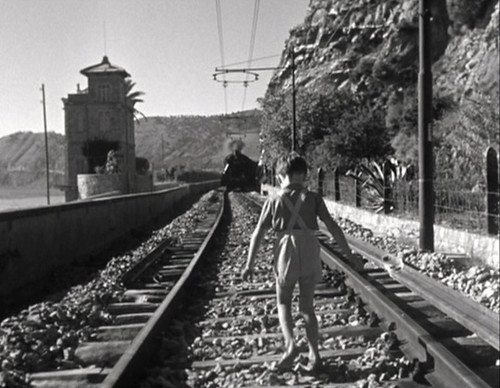*SPOILERS BELOW*
The Italian Neorealist movement of the 1940’s and 50’s has proven one of the most influential eras of art cinema from around the world. With its beautiful minimalism and tender treatment of its average characters’ troubles, films of this movement are generally true-to-life, and often very tragic. Along with fellow directors Fellini and Rossellini, Vittorio De Sica reigned supreme in this particular era. Although he is more famous for such weighted films as The Bicycle Thief and Umberto D., his prowess first came into light with the influential The Children Are Watching Us. This film shows a painfully intimate portrayal of a small family’s slow disintegration, a topic that remains all too prevalent in the human experience. Though the narrative itself is omniscient, much of the story’s content is shown through the perspective of the young son, Pricó. As viewers have access to seeing daily occurrences as Pricó sees them, they also, as a result, share the pain and frustration of both his naïvety and the forced ambiguity of his parents as they try to keep their problems as distant from their child as possible.
The film begins with a scene at a local park, as a large crowd looks upon a ongoing puppet show (Pricó and his mother Nina being among the crowd). Frantically, the puppets are engaging in a playful sword-fight, as the members of the audience - many of them children - watch; some in amusement, others, particularly the youngest children, in fear. This is a direct reference to the title of the film, and a thematic foreshadowing of the events to come. Soon, we are informed that Nina has fallen in love with a man named Roberto, with whom she plans to run away. That night, she does just that, abandoning both her child and her husband Andrea. Later, she does return, though not without leaving a deep impression onto the family. The main concern through the majority of the film’s duration relies on Pricó’s vain attempts to make sense of what is going on, to get a firm handle on the family structure, which is inevitably destined to fall apart.
A major characteristic that accompanies the narrative is that of its lack of cohesion of the situation at hand. From the moment that Pricó, Nina, and Andrea are in the same room together, there is an undeniable level of tension between the parents; it’s quite apparent that something isn’t right with their relationship. However, since Pricó is always present, they make it a case to never quarrel around him; moreover, since the story is from Pricó’s perspective, we know as much as he does - which is next to nothing. Later on, when Pricó comes onto an argument between Nina and Roberto, the reason for the crumbling of their own relationship is also left unexplained. The film aims at presenting how such decisions toward silence and distancing affect the well-being of the child, who is utterly confused over the situation he does not and cannot completely understand.
Disheartening for viewers is the fact that, while we share Pricó’s point-of-view, there’s not much within his power to manipulate and improve. His childish essence prevents him from being a conventional “hero”, as the problems that the adults undergo are beyond his own control. One of the more beautifully surreal sequences of the film comes in the form of a montage, as Pricó and his father are riding away in a train. As Pricó looks out of the window, viewers are presented with a series of symbolic images: water pouring into a glass, chaotic dancing puppets, the face of his grandmother. Finally, there is an image of Nina walking through a dark abyss, before she is taken away by Roberto. This montage is set to the locomotion of the traveling train, and is, therefore, representative of the young boy’s situation as a whole. Pricó is aware that something isn’t completely right, but does not fully comprehend the situation and, therefore, cannot change it. Everything that happens is simply moving past him, like scenery out of a moving train, with no possibility of controlling the events.
There are a vast array of individual memorable scenes that are particularly important and prominent in its overall impact. During one of the movie’s few happy moments, the family enjoy a Mother’s Day dinner at the dining room table. This scene, however, is accompanied by an ominous, tragic background violin score. We learn later than this is a foreshadowing of a quarrel between Nina and Roberto, which later occur in that very same room. Another scene involves a disenchanted Pricó finally running away from home; his constantly being shooed away by nearly every adult he comes across painfully continues the theme of neglect and abandonment.
In certain scenes, there are frequent moments of contrast between the carefree, innocent world of childhood, and the corrupting lovesickness that often accompanies adult relationships. The Children Are Watching Us is the story of what happens when these two different worlds collide, and the devastating impact it could leave upon all parties involved. Moreover, this film relies much on perspective of events, how the distancing of the issues presented can be problematic, but also provide more insight than immediately apparent, calling upon a rich cinematic experience. Above all else, this film is a masterpiece that treats a touchy, yet completely ordinary, subject with a fair amount of sensitivity and delicate account toward its tragic unfolding. Though ambiguous in its motives, it treats all characters sympathetically; there is no “good” or “bad” side, but there is an bold statement of humanity, apparent in each and every moment of this completely beautiful piece of work.




No comments:
Post a Comment